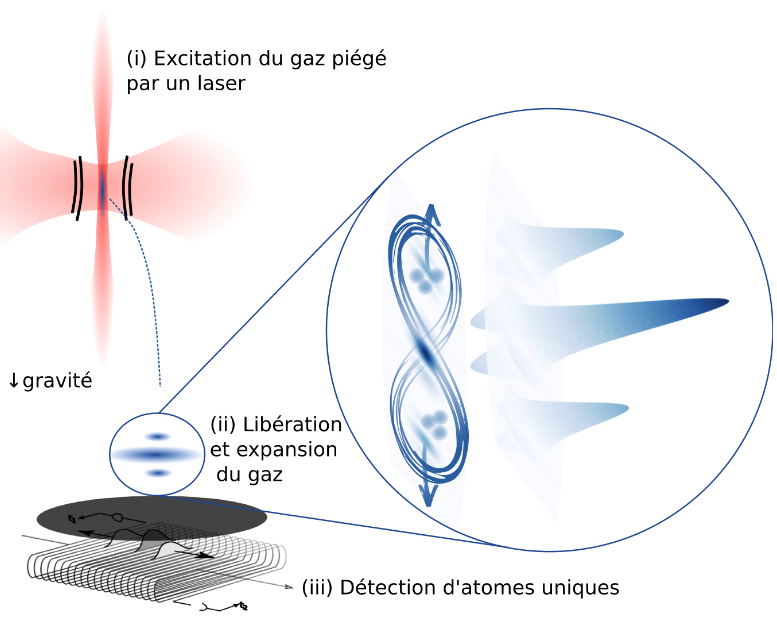Entanglement in an analog cosmological preheating
Probing entanglement of collective excitations in a parametrically excited Bose-Einstein condensate
Related publication: Gondret V, Lamirault C, Dias R et al., Observation of entanglement in a cold atom analog of cosmological preheating, arXiv:2506.22024 (2025), PDF or HTML. See also this talk, this poster or the Chapter 6 of my thesis.
By shaking a cold gas of helium atoms, we have have succeeded in creating excitations out of the quantum vacuum, in a process analogous to the creation of matter in cosmology.
In quantum field theory (our best description of particle physics), “empty” space is never truly empty. Rather, it is teeming with vacuum fluctuations, tiny flickering motions with the potential to become particles if acted upon by some physical process. One such process is parametric amplification, a resonant response to oscillation which is ubiquitous in physics, explaining situations as diverse as the appearance of waves on the surface of a vibrating liquid or the creation of particles in the early universe.
 Beyond particle physics, excitations known as phonons – quantized sound waves – exist in matter, and behave similarly. Our experiment concerns phonons in a cold cigar-shaped helium gas, held in place by laser beams. The intensity of a laser is modulated in time in order to induce an oscillation of the gas and trigger parametric amplification (i). The gas is then released, and each phonon created transfers its velocity to a witness atom that escapes from the main cloud during the cloud’s free fall (ii). A microchannel plate coupled to delay lines (iii) then enables the measurement of the arrival time and position of individual atoms. The phonons thus created appear as two density peaks on either side of the main peak in the time-of-flight signal. However, since the phonons already present before the parametric excitation—due to the non-zero temperature of the gas—are also amplified, an additional verification was needed to confirm that vacuum fluctuations had indeed served as the seed. This was demonstrated by showing that the phonons are created as entangled pairs, meaning that they exhibit correlations too strong to be described by classical (non-quantum) physics.
Beyond particle physics, excitations known as phonons – quantized sound waves – exist in matter, and behave similarly. Our experiment concerns phonons in a cold cigar-shaped helium gas, held in place by laser beams. The intensity of a laser is modulated in time in order to induce an oscillation of the gas and trigger parametric amplification (i). The gas is then released, and each phonon created transfers its velocity to a witness atom that escapes from the main cloud during the cloud’s free fall (ii). A microchannel plate coupled to delay lines (iii) then enables the measurement of the arrival time and position of individual atoms. The phonons thus created appear as two density peaks on either side of the main peak in the time-of-flight signal. However, since the phonons already present before the parametric excitation—due to the non-zero temperature of the gas—are also amplified, an additional verification was needed to confirm that vacuum fluctuations had indeed served as the seed. This was demonstrated by showing that the phonons are created as entangled pairs, meaning that they exhibit correlations too strong to be described by classical (non-quantum) physics.
The observation of this entanglement, theoretically predicted, had until now never been achieved experimentally. The results of the experiment carried out in the laboratory, published in Physical Review Letters [1], were made possible by major theoretical and experimental advances. A collaboration with other researchers at Université Paris-Saclay made it possible to better describe the system’s dynamics and to better understand how the quantum entanglement between phonons is affected by the properties of the gas, such as its density or temperature [2,3]. Within the Charles Fabry laboratory, additional theoretical work established a connection between the notion of quantum entanglement and the measurement of correlation functions between particles [4]. Experimentally, the researchers took advantage of a unique property of the species used (metastable helium) which allows for the electronic detection of individual atoms via a detector developed within the University [5]. Finally, this work was made possible thanks to numerous improvements to the experimental setup, such as the manipulation of atoms using temporally shaped light pulses [6], which enabled continuous data acquisition 24 hours a day for three weeks. The results of this research open the way to studying the behavior of the gas when the many created phonons begin to interact with one another. This regime exhibits analogies with the thermalization of particles in the early universe, but remains difficult to describe analytically. The good agreement observed between theory and experiment validates the use of this experimental system as a quantum simulator to study the subsequent dynamics.
[1] Gondret, V. et al. Observation of entanglement in a cold atom analog of cosmological preheating. To appear in Phys. Rev. Lett.
[2] Robertson, S., Michel, F. & Parentani, R. Controlling and observing nonseparability of phonons created in time-dependent 1D atomic Bose condensates. Phys. Rev. D 95, 065020 (2017).
[3] Micheli, A. & Robertson, S. Phonon decay in 1D atomic Bose quasicondensates via Beliaev-Landau damping. Phys. Rev. B 106, 214528 (2022).
[4] Gondret, V. et al. Quantifying Two-Mode Entanglement of Bosonic Gaussian States from Their Full Counting Statistics. Phys. Rev. Lett. 135, 100201 (2025).
[5] Schellekens, M. et al. Hanbury Brown Twiss Effect for Ultracold Quantum Gases. Science 310, 648–651 (2005).
[6] Leprince, C. et al. Coherent coupling of momentum states: Selectivity and phase control. Phys. Rev. A 111, 063304 (2025).